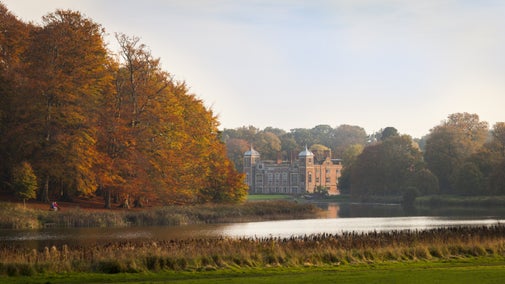
Donate
Everyone needs nature, now more than ever. Donate today and you could help people and nature to thrive at the places we care for.

Caring for Coughton goes on all year round with much of the work being done behind the scenes. From deep cleans and keeping accurate records to protecting the landscape and restoring treasures with your support, find out more about our work at Coughton.
Over the closed winter period the house team conduct a deep clean of the house and its collection, completing big jobs which it isn’t possible to complete while open such as checking all the books in the Saloon and waxing the floors.
The team work through each room, cleaning it from top to bottom. Cleaning requires lots of different brushes depending on the item being cleaned and jobs such as dusting the paintings which requires specialist training.
While they clean the team are also checking the condition of the items and whether there has been any damage or deterioration.
Every year an inventory check is also completed. The team will go through each room in the house ensuring that all the items in the collection are where they should be.
Items are often moved for conservation or display reasons and when that happens the record on the digital collections database needs to be updated. Updates are made throughout the year, but the annual check allows for a full, thorough check.

The team are always looking to improve their collection management standards, ensuring improved cataloguing of the collection, photographing it and inventory-marking objects.
Every few years the items in storage are also checked and photographed to aid with identification and condition checking.
Traps are positioned around the house to check for the presence of pests which could damage the collection. These traps are checked quarterly to monitor the levels of certain pests such as moths, carpet beetles, silverfish and furniture beetles.
By checking quarterly, the team can identify trends and hopefully catch a growing problem before it gets too big. It also tells the team whether it’s too damp or humid.
Alongside the daily and annual cleaning, larger conservation projects have also taken place to help protect and restore Coughton. Often this work is supported by onsite fundraising such as raffle ticket sales.
With your ongoing support, we're able to continue our vital conservation work. Thank you for helping to protect these special places.

Everyone needs nature, now more than ever. Donate today and you could help people and nature to thrive at the places we care for.
Coughton Court is home to a number of historic items. Take a closer look at two of the most important items in the collection – the Throckmorton coat and the Tabula Eliensis.

Twenty-one generations of the Throckmorton family have lived at Coughton since 1409. Over six centuries there are many stories to tell, including that of the gunpowder plot.

Find out more about working at Coughton Court and how you can play your part in looking after this Tudor house full of Catholic treasures.

Explore the house and collections at Coughton Court, which has been home to the Throckmorton family for over six centuries and continues to be their home today.

The Throckmorton family created and manages the award-winning garden at Coughton. Highlights include the walled garden, lake, knot garden, vegetable garden, orchard and bog garden.

Visit Coughton Court for family-friendly events and activities in the house and garden, including woodland walks and wildlife spotting.

Read about our strategy, which focuses on restoring nature, ending unequal access and inspiring more people.

We believe that nature, beauty and history are for everyone. That’s why we’re supporting wildlife, protecting historic sites and more. Find out about our work.
